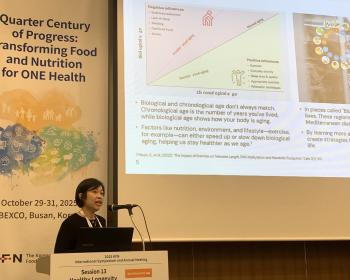Predicting Ovarian Cancer Recurrence First Identification of a New Biomarker...Expectation of Customized Treatment
Apr 28, 2025
Ovarian cancer is a cancer in the ovary that is located on both sides of the uterus to produce follicles and make female hormones. It is not easy to feel self-awareness symptoms in the early stages of ovarian cancer, so most of them are diagnosed in the late stages (3rd to 4th stages). Predicting recurrence is important because the recurrence rate of end-stage ovarian cancer is high and the more it recurs, the more resistant it becomes, making it difficult to treat it. A study that integrated imaging and dielectric analysis of patients with ovarian cancer to discover new ovarian cancer recurrence genes was published in international journals.
This is the first study to identify the molecular characteristics of recurrent ovarian cancer by integrating CT images and spatial transcriptomics analysis techniques.
Spatial transcriptome technology is an advanced biotechnology technique that analyzes cell gene expression information with spatial location in tissues and is very useful for identifying cell-to-cell interactions in complex diseases such as cancer. The co-corresponding authors of this study are Professor Han Mi-ryeong of the Department of Life Sciences at Incheon National University, and the first co-author is Professor Joo Hye-yeon of Incheon National University and Professor Yoon Seo-yeon of the Department of Radiology at Seoul St. Mary's Hospital.
The research team investigated eight high-grade serous ovarian cancer patients with many recurrences among ovarian cancer by dividing them into recurrence and non-recurrence patients. Serous ovarian cancer is one of the five subtypes of epithelial tumors, which account for 80% of ovarian cancer, and secretes clear fluid (serous fluid). Serous ovarian cancer is divided into high-grade and low-grade, most of which are high-grade serous ovarian cancer. High-grade serous ovarian cancer is the deadliest malignant tumor among gynecological cancers, with a 10-year survival rate of less than 30%, and 80% of patients relapse, so we targeted the factor target that causes recurrence.
Preoperative CT imaging revealed differences in the expression of genes in spatial transcriptomic examination, depending on the nodular peritoneal metastasis, peritoneal metastasis of the furrow next to the colon, extensive peritoneal metastasis location, and the degree of peritoneal thickening.
An analysis comparing the recurrence group with the recurrence group and the non-recurrence group revealed that the control of the inflammatory response (TNF-α signal through NF-κB) and the oxidative phosphorylation pathway of cytoplasm (the process by which energy is generated in the cell) are the main factors contributing to the recurrence.
In the patient group without recurrence, less expression of the PTGDS gene was identified as an indicator of good prognosis, and it was also associated with the small range of peritoneal metastasis in preoperative CT. In addition, chemotaxis-related markers CXCL14 and NTN4, and immunomodulatory-related markers DAPL1 and RNASE1 were identified as good prognostic factors. These markers were found to be characteristic factors that appear in the patient group with low recurrence probability through spatial transcriptomic examination and radiogenomic analysis.
Professor Choi Yoon-jin said, `We hope that it will be of practical help in improving the survival rate of ovarian cancer patients by predicting the possibility of recurrence, developing customized treatment plans optimized for individual patients, and developing new drugs targeting biomarkers discovered in the future.' The findings were recently published in the renowned international journal Biomarker Research in the field of personalized medicine and biomarkers.
This is the first study to identify the molecular characteristics of recurrent ovarian cancer by integrating CT images and spatial transcriptomics analysis techniques.
Spatial transcriptome technology is an advanced biotechnology technique that analyzes cell gene expression information with spatial location in tissues and is very useful for identifying cell-to-cell interactions in complex diseases such as cancer. The co-corresponding authors of this study are Professor Han Mi-ryeong of the Department of Life Sciences at Incheon National University, and the first co-author is Professor Joo Hye-yeon of Incheon National University and Professor Yoon Seo-yeon of the Department of Radiology at Seoul St. Mary's Hospital.
The research team investigated eight high-grade serous ovarian cancer patients with many recurrences among ovarian cancer by dividing them into recurrence and non-recurrence patients. Serous ovarian cancer is one of the five subtypes of epithelial tumors, which account for 80% of ovarian cancer, and secretes clear fluid (serous fluid). Serous ovarian cancer is divided into high-grade and low-grade, most of which are high-grade serous ovarian cancer. High-grade serous ovarian cancer is the deadliest malignant tumor among gynecological cancers, with a 10-year survival rate of less than 30%, and 80% of patients relapse, so we targeted the factor target that causes recurrence.
Preoperative CT imaging revealed differences in the expression of genes in spatial transcriptomic examination, depending on the nodular peritoneal metastasis, peritoneal metastasis of the furrow next to the colon, extensive peritoneal metastasis location, and the degree of peritoneal thickening.
An analysis comparing the recurrence group with the recurrence group and the non-recurrence group revealed that the control of the inflammatory response (TNF-α signal through NF-κB) and the oxidative phosphorylation pathway of cytoplasm (the process by which energy is generated in the cell) are the main factors contributing to the recurrence.
In the patient group without recurrence, less expression of the PTGDS gene was identified as an indicator of good prognosis, and it was also associated with the small range of peritoneal metastasis in preoperative CT. In addition, chemotaxis-related markers CXCL14 and NTN4, and immunomodulatory-related markers DAPL1 and RNASE1 were identified as good prognostic factors. These markers were found to be characteristic factors that appear in the patient group with low recurrence probability through spatial transcriptomic examination and radiogenomic analysis.
Professor Choi Yoon-jin said, `We hope that it will be of practical help in improving the survival rate of ovarian cancer patients by predicting the possibility of recurrence, developing customized treatment plans optimized for individual patients, and developing new drugs targeting biomarkers discovered in the future.' The findings were recently published in the renowned international journal Biomarker Research in the field of personalized medicine and biomarkers.
|
This article was translated by Naver AI translator.














